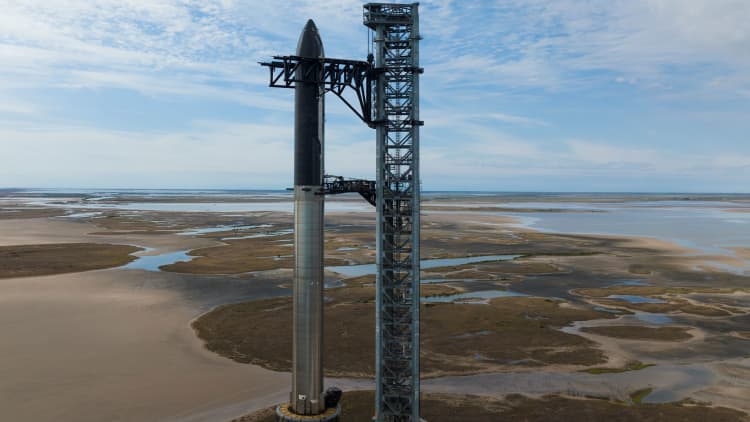SpaceX Starship rocket launches fourth test spaceflight

SpaceX completed a test flight of its Starship rocket for the first time on Thursday, as the company pushed development of the mammoth vehicle past new milestones.
Elon Musk’s company launched Starship at about 8:50 a.m. ET from its Starbase facility near Boca Chica, Texas.
A few minutes after launch, the rocket’s booster successfully splashed down in the Gulf of Mexico, a new milestone for its development. This was the first time SpaceX returned the booster in one piece â a controlled return of the booster is key to the company’s long term goal of being able to launch and land Starship regularly, a practice it’s made routine with its Falcon 9 rockets.
About an hour after the launch, Starship visibly survived reentry through the Earth’s atmosphere and the company confirmed that the rocket splashed down in the Indian Ocean to complete the mission.
“Splashdown confirmed!” SpaceX posted on social media after the flight.
SpaceX’s next-generation Starship spacecraft, atop its powerful Super Heavy rocket, lifts off on its third launch from the company’s Boca Chica launchpad on an uncrewed test flight, near Brownsville, Texas, U.S. March 14, 2024.Â
Cheney Orr | Reuters
SpaceX has flown the full Starship rocket system on three spaceflight tests previously, with launches in April 2023, November and March. Each of the test flights have achieved more milestones than the last, but each result destroyed the rocket before the flight’s end.
The company’s rocket flew the furthest in its third test flight, allowing SpaceX to test new capabilities including opening and closing the payload door once in space â which would be how the rocket deploys payloads such as a satellites on future missions â and transferring fuel during the flight in a NASA demonstration.
The Starship system is designed to be fully reusable and aims to become a new method of flying cargo and people beyond Earth. The rocket is also critical to NASA’s plan to return astronauts to the moon. SpaceX won a multibillion-dollar contract from the agency to use Starship as a crewed lunar lander as part of NASA’s Artemis moon program.
SpaceX heavily emphasizes an approach of building “on what we’ve learned from previous flights” in its approach to develop Starship. The company says its strategy focuses on “recursive improvement” to the rocket, where even test flights with fiery outcomes represent progress toward its goal of a fully reusable rocket that can deliver people to the moon and Mars.
Musk last year said he expected the company to spend about $2 billion on Starship development in 2023.
Goals for fourth flight
SpaceX’s next-generation Starship spacecraft atop its powerful Super Heavy rocket is prepared for a third launch from the company’s Boca Chica launchpad on an uncrewed test flight, near Brownsville, Texas, U.S. March 13, 2024.Â
Joe Skipper | Reuters
There are no people on board this Starship spaceflight. The company’s leadership has previously emphasized that SpaceX expects to fly hundreds of Starship missions before the rocket launches with any crew.
SpaceX will be looking to surpass the third test flight’s milestones. The company wrote in an update on its website that the fourth flight “turns our focus from achieving orbit to demonstrating the ability to return and reuse Starship and Super Heavy.”
“The primary objectives will be executing a landing burn and soft splashdown in the Gulf of Mexico with the Super Heavy booster, and achieving a controlled entry of Starship,” SpaceX wrote.
The company says it’s completed a number of software and hardware changes to Starship, aimed at increasing the rocket’s reliability.
The rocket

Starship is both the tallest and most powerful rocket ever launched. Fully stacked on the Super Heavy booster, Starship stands 397 feet tall and is about 30 feet in diameter.
The Super Heavy booster, which stands 232 feet tall, is what begins the rocket’s journey to space. At its base are 33 Raptor engines, which together produce 16.7 million pounds of thrust â about double the 8.8 million pounds of thrust of NASA’s Space Launch System rocket, which launched for the first time in 2022.
Starship itself, at 165 feet tall, has six Raptor engines â three for use while in the Earth’s atmosphere and three for operating in the vacuum of space.
The rocket is powered by liquid oxygen and liquid methane. The full system requires more than 10 million pounds of propellant for launch.
Read the original article here






